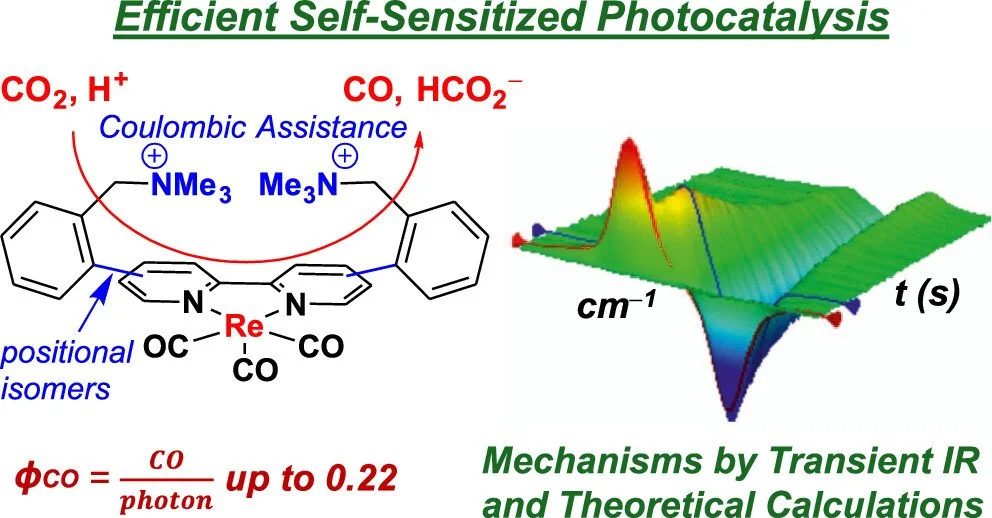Efficient Self-Sensitized Photochemical CO₂ Reduction Using [Re(bpy²⁺)(CO)₃(I)]²⁺ and [Re(bpy²⁺)(CO)₃(CH₃CN)]³⁺ Photocatalysts with Pendent Ammonium Cations
Rhenium(I) tricarbonyl complexes fac-[Re(bpy)(CO)₃(L)]ⁿ⁺ are the classic examples of self-sensitized photocatalysts capable of the dual roles of light absorption and catalysis. In this work, a series of dicationic halido or tricationic solvento complexes fac-[Re(bpy²⁺)(CO)₃X]ⁿ⁺(PF₆)ₙ (where X = Cl⁻ or I⁻ (n = 2), or CH₃CN (n = 3) and bpy²⁺ is bipyridine modified by two −CH₂–(NMe₃)⁺ tetra-alkylammonium cations) have been investigated as self-sensitized and sensitized CO₂ reduction photocatalysts. Four structural isomers differing in the cation position have been tested in N,N′-dimethylacetamide solvent (DMA) using 1,3-dimethyl-2-phenyl-2,3-dihydro-1H-benzimidazole (BIH) as the electron donor, and the position of the cationic pendants has a significant impact on the catalyst turnover number and quantum efficiency (ϕ). Up to 455 self-sensitized turnovers of CO and a high photon efficiency (ϕCO) of 22% have been achieved. Time-resolved infrared spectroscopy and theoretical calculations were used to characterize the catalytic cycle including the ligand exchange between one-electron reduced (OER) halido and solvento species as well as the binding of CO₂ to the putative two-electron reduced (TER) species. The CO₂-reactive TER catalyst was formed by disproportionation or intramolecular electron transfer between two forms of the OER catalyst as indicated by the formation of the fully oxidized catalyst concurrent with CO₂ binding. When [Ru(bpy)₃]²⁺ was used as a sensitizer, catalyst durability improved, and the selectivity toward formate increased as high as 3.3:1 over CO (total TON = 1370) due to acidification of the reaction, which promotes formation of the hydride intermediate, as BIH was consumed and deprotonated.
Wang, Z.; Rotundo, L.; Ertem, M. Z.; Polyansky, D.; Manbeck, G. F. Efficient Self-Sensitized Photochemical CO₂ Reduction Using [Re(bpy²⁺)(CO)₃(I)]²⁺ and [Re(bpy²⁺)(CO)₃(CH₃CN)]³⁺ Photocatalysts with Pendent Ammonium Cations, J. Am. Chem. Soc. 2025, 147(22), 18796–18813. https://doi.org/10.1021/jacs.5c02523

